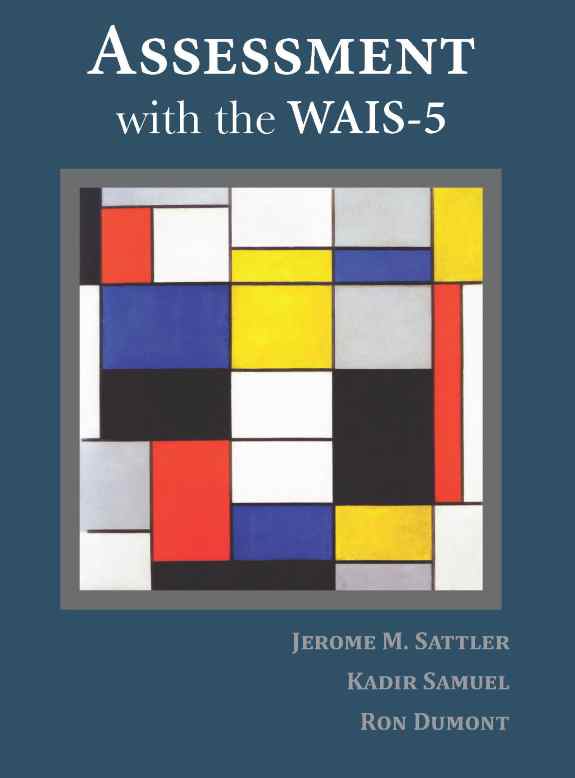|
Reviewers'
Comments
Complete
Table of Contents
Preface
Order/
Contact
Home
|
PREFACE
ASSESSMENT with the WAIS-5
Jerome M. Sattler, Kadir Samuel, and
Ron Dumont
Copyright 2025, 468 pages
Hardbound, 8.5 x 11
ISBN 979-8-9928867-0-2
- |
|
Assessment with the WAIS-5 is designed as
both a teaching text and a reference source for students and
professionals. The text provides an in-depth analysis of a major
instrument useful for the cognitive assessment of older adolescents and
adults. Some notable features of the text include the following:
- A chapter covering general guidelines for administering
tests
- A thorough discussion of the psychometric properties of the
WAIS-5
- An in-depth presentation of each WAIS-5 subtest, including a
description, rationale, factor analytic findings, reliability and
correlational highlights, administrative guidelines, and interpretive
suggestions
- Guidelines for interpreting the WAIS-5 Full Scale, WAIS-5 primary
index scales, and WAIS-5 ancillary index scales
- Checklists that can be used for identifying possible vision
problems, hearing problems, or brain injury problems during an
assessment
- A form for recording psychological and physical difficulties that
might be observed during test administration and a parallel table
explaining each psychological and physical difficulty that appears on
the form
- Guidelines for using an interpreter
- Guidelines for administering tests to individuals with special
needs, including test accommodations and test modifications
- A chapter discussing neuropsychological assessment, including how
to use the WAIS-5 as part of a neuropsychological assessment
- A chapter covering aging and cognitive ability
- A chapter covering a description of the major forms of dementia
- Appendixes with confidence intervals, guidelines for interpreting
WAIS-5 subtests and scales, relevant CattellHorn-Carroll abilities
associated with each subtest and scale, and much more
This edition contains several learning aids. These
include
-
A list of major headings, together with goals
and objectives, at the beginning of each chapter
-
A “Thinking Through the Issues” section; a
summary of each major topic; a list of key terms,
each linked to the page on which it appears; and a series of study
questions at the end of each chapter
-
Detailed guidelines for administering each
WAIS–IV subtest covering background considerations, starting
considerations, reverse sequence considerations, discontinue
considerations, scoring guidelines, and completion of the Record Form,
as well as a checklist for recording whether each guideline was observed
-
Report writing principles
-
A glossary of major terms related to dementia
-
Checklists for evaluating a student’s
competency in administering the WAIS-5 and WAIS-5 Q-interactive
Edwin G. Boring said, “Intelligence is
whatever intelligence tests measure.” Although this comment may
have been facetious, it strikes a chord with the text authors. We wonder,
Does the revised structure of the WAIS-5 give a more valid picture of the
nature of intelligence than the former edition? The new edition will, of
course, need to be investigated more extensively before a final judgment
can be made about its value as a cognitive assessment instrument. Our
field needs to study, in particular, how the major changes—the addition of
three subtests new to this edition (Running Digits, Naming Speed Quantity,
and Set Relations), the splitting of the WAIS–IV Digit Span subtest into
three independent subtests (Digits Forward, Digit Sequencing, and Digits
Backward), and the inclusion of two WMS–5 subtests (Symbol Span and
Spatial Addition)—contribute to our understanding of the cognitive
functioning of both older adolescents and adults.
Note to instructors: An Instructor’s Manual
prepared by Kadir Samuel and Ron Dumont is also available, with
multiplechoice questions and PowerPoint™ presentations highlighting the
main points of each chapter in Assessment with the WAIS-5.
Back to top
|

